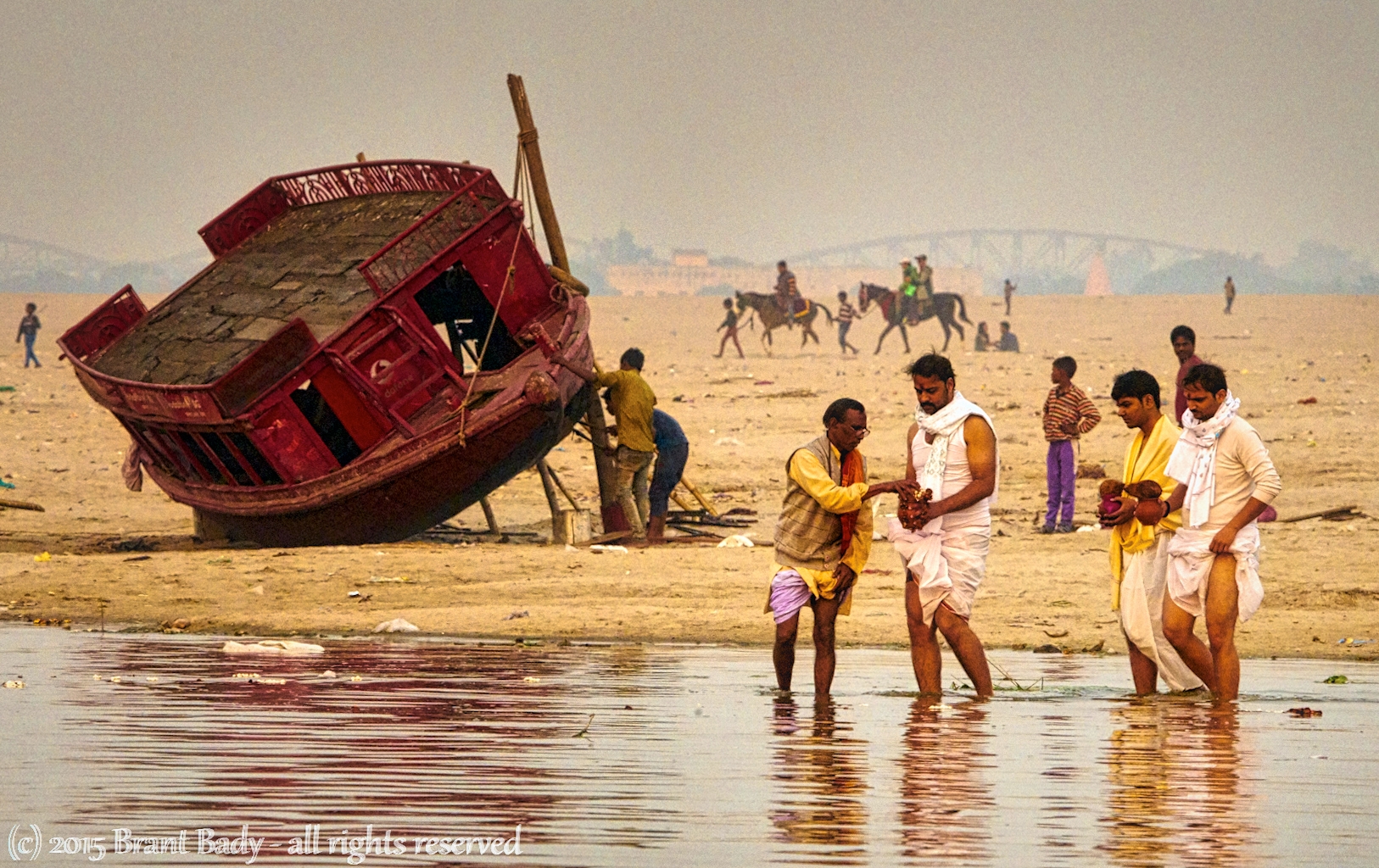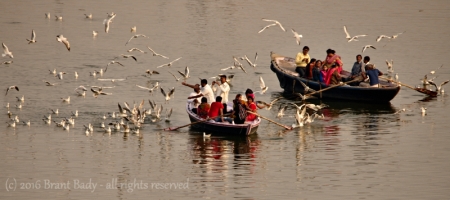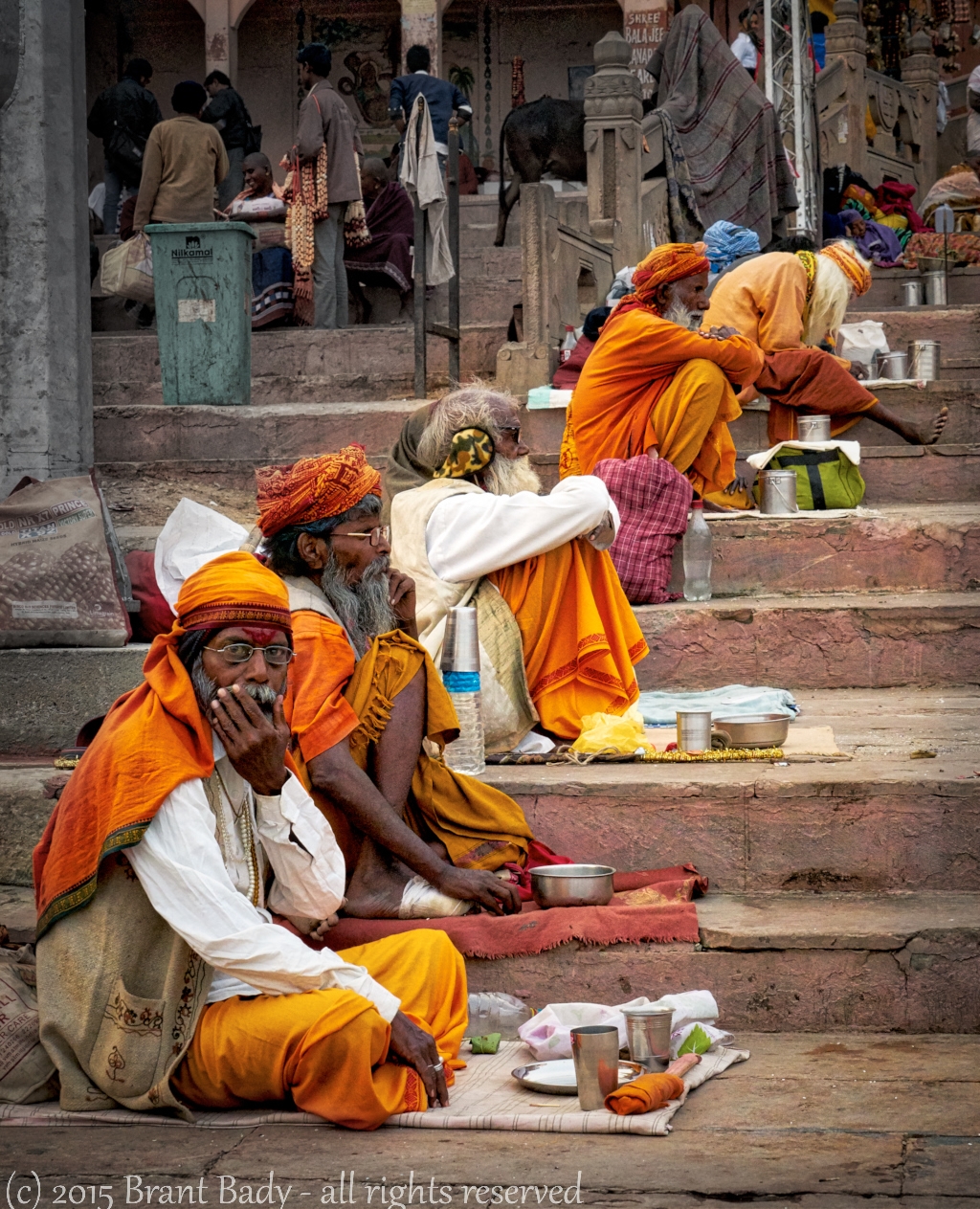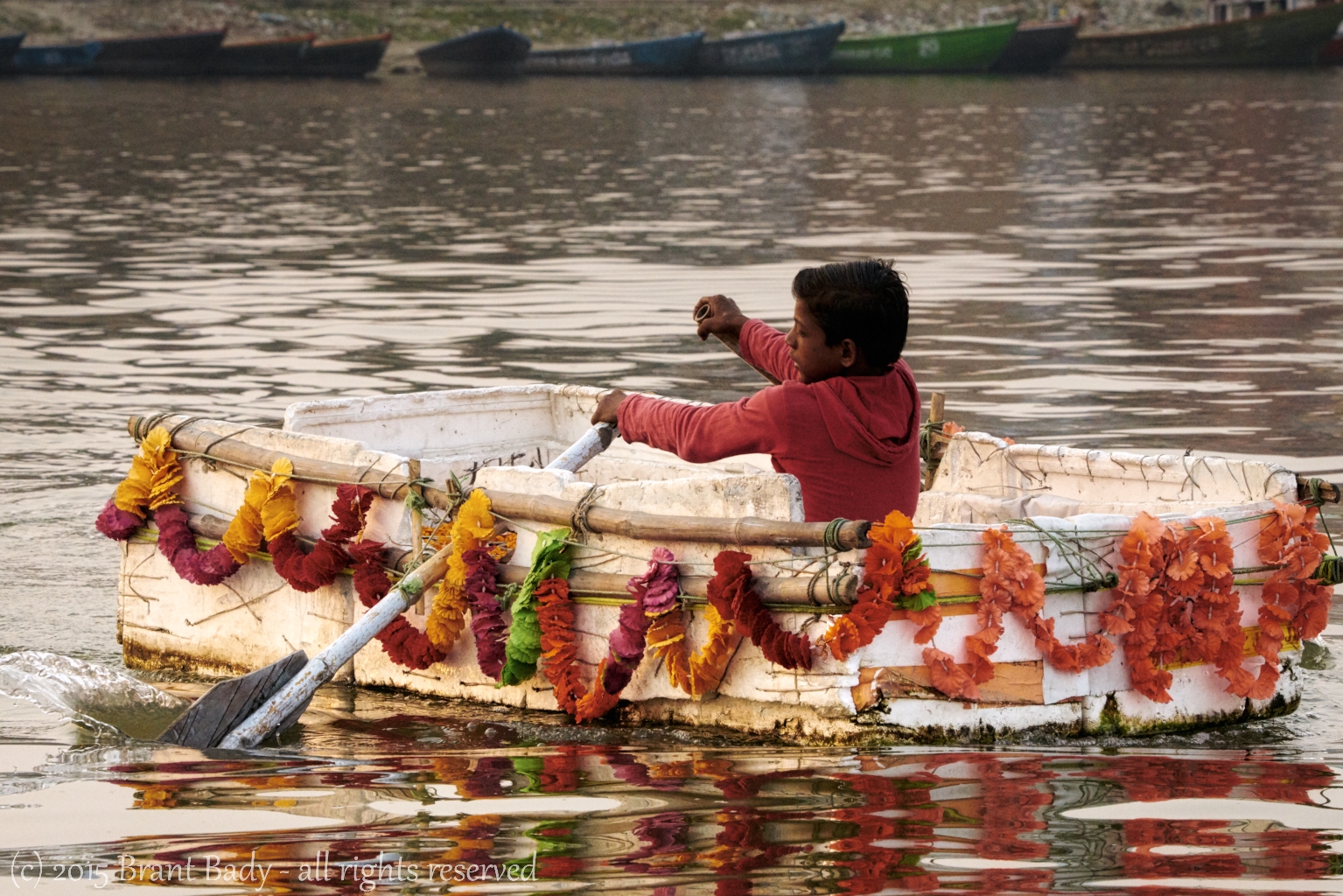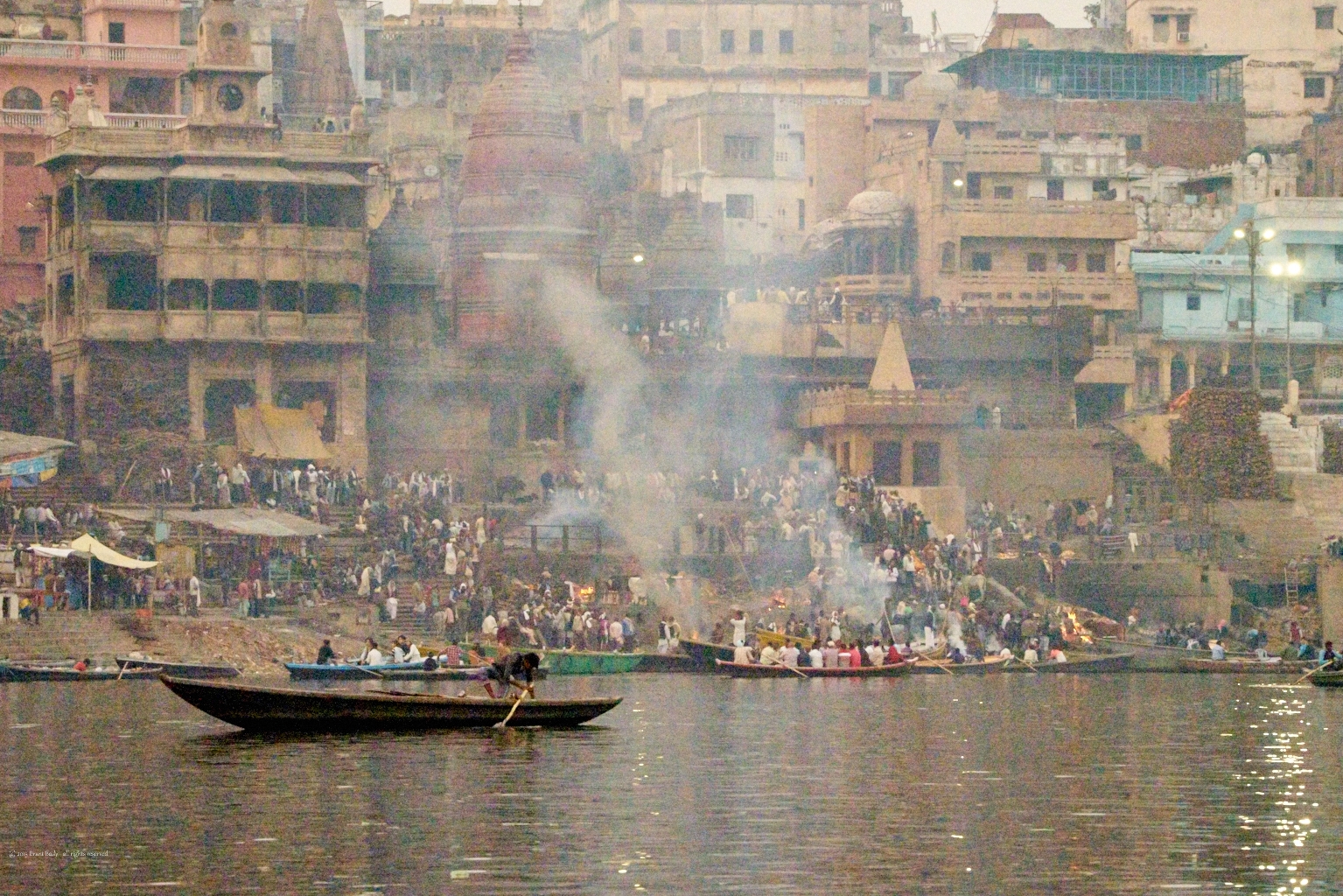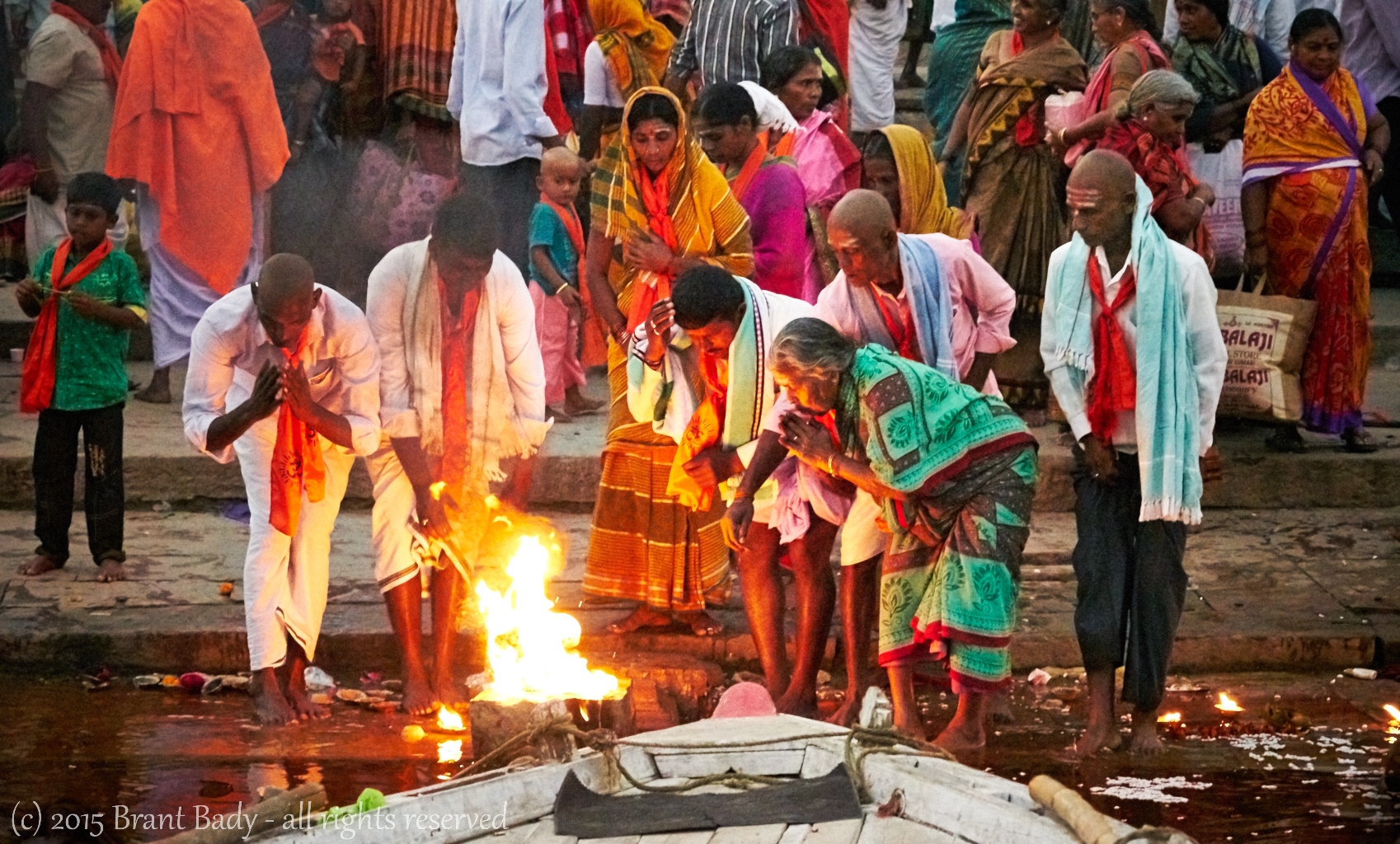I didn’t quite understand why all my Indian friends laughed like hell and smiled a lot when I said I was going to Varanasi, that is until I had actually spent some time. In, truth, its a bit over the top at first impression, not only being the holiest of the seven holy cities in India, but the activities that take place there seem to defy western “common sense” in ways that only devotion, belief, and faith can.
What struck me the most was how connected Varanasi is in very practical ways to the endless cycles of birth and rebirth. In some ways time seems suspended, as ancient practices continued to be followed to this day, yet in other ways the ebb and flow of human life is symbolized by the slow, but relentless flow of Mother Ganga – unstoppable, one can only immerse oneself in the flow of life, just as devotees immerse themselves in the Ganges to do their ablutions, as bathing in the Ganges is considered a way to wash away ones sins.
Unfortunately is it can also be extremely dangerous health wise – given that the normal coliform limit for bathing water is about 500 parts per 100 milliliters of water, whereas the count at or around Varanasi has been measured as high as 1.5 million per 100 milliliters.
Hindus also believe that if one dies in Varanasi, then one will immediately go to Nirivanna, thereby escaping the nearly endless cycle of birth and rebirth. Historically it has been common practice for the dying to make their last pilgrimage to Varanasi (or to be taken there by their families), to take this shortcut to enlightenment and while this still happens, in recent years the number of low cost moksha guesthouses/hospices that served this purpose have been dwindling in numbers, replaced by more upscale guesthouses catering to the tourist trade. A more detailed explanation can be found in this article http://www.independent.co.uk/news/world/asia/varanasi-the-last-stop-before-nirvana-1805245.html
Varanasi is an ancient city, with archeological evidence dating back to 20th Century BC, making it one of the worlds old cities that has been continually inhabited since ancient times. Not just a city important to the Hindu faith, it is also believed that the Buddha founded Buddhism near here in 528 BC, and to this day there are also a significant number of historically important mosques in the city as well.
The antiquity of the city can make it a bit challenging for visitors, as often guesthouses are located far down narrow alleyways, to which the only practical approach is to walk – which can be an obstacle course certainly with any kind of luggage – backpacks are very practical here. Also a great idea to download and cache a local copy of the area using google maps on your phone, and then use the cell towers to help pinpoint your location – that and get a clear confirmation of the address of your lodging.
The guesthouse I had selected was quite close to one of the most important ghats, and purported to have a great view of the Ganges. I had hoped that meant a balcony from which I could get some great telephoto shots of the sunset and river from a unique and high viewpoint, but that was pretty much wishful thinking on my part… my great view was just a small window. So after settling in and getting some quick directions as to the best way down to the river, off I headed camera in hand.
One of the first characters I came across was a Sadhu – a Hindu holy man, who has given up material possessions for a spiritual life.
This guy was strolling along the top of the ghat, and stood out like a sore thumb with his red and yellow robes and his huge flowing and yellowing beard. I popped off a quick burst of shots from a distance – but I was busted immediately – he noted that I was taking photos and came over right away. He had a huge smile and a completely infectious gravelly laugh, and I found myself laughing with him, and immediately I liked him. He went into a pose for me (not something that I actually wanted as I much prefer candid shots where the subject is not posing or acting), and while I pretty much NEVER pay people to take their photos, I did give him a donation out of huge respect for his faith and devotion.
I was also down at the ghats to try to arrange for a boat ride the following morning, and was advised by my guesthouse to look a bit further to the right down the river, and try to get an older guy as they would be more reasonable in terms of costs.
While I thought I had picked out someone that was older, he was just a tout or controller, and the actual boatman was to be a very young guy. We made arrangements to meet very early next morning, at something like 5:30 am in order to catch the best light as dawn broke. The young guy wanted what I thought was a price on the high side, but I explained to him that I was a photographer and what I wanted, and he readily understood – so it was better to have a boatman who charged more but was sympatico to my needs, than someone offering a cheap rate and no flexibility.
I then had some practical business to take care of, I wanted to find some beer for the evening, and this being a holy city, I knew it was going to be a bit challenging. I headed up one of the main streets away from the ghats and just started looking – in India, the clearest indication of a liquor outlet is to find some kind of grotty establishment with bars in front, and huge crowd of guys milling about holding black plastic bags (so that they can carry their alcohol discretely). I wasn’t having too much luck in spotting a place, and as I passed an alleyway, another tout came out as and asked me what I was looking for? I said beer and he offered to guide me there, saying that he actually was a rickshaw driver and that if I needed a tour of the town he could assist. Now normally this would be problematic as help of this kind is not usually offered without a catch, i.e. some form of compensation. However what I had learned in Sri Lanka as well as India, was that pricing, particularly for spirits is often “quite flexible”, and in fact its cheaper to get a local to purchase it at the going rate rather than going in and winding up paying the tourist rate. In the end you likely pay the same, but at least the money gets spread around a bit more that way.. and clearly I could have burned quite a lot of time wandering around randomly looking for a place.
So we set off on foot actually, and walked easily a dozen blocks before coming to an outlet that had cold beer. He didn’t offer to take the money and buy it, so in fact I wound up paying quite an inflated rate. Again I was surprised in that he actually didn’t ask for any compensation, instead he made pitch for a rickshaw tour. I told him he would be #1 if that’s what I needed, and I made sure he gave me clear information as to where I could find him tomorrow if need be. We parted ways with a handshake, and I continued on my way, being impressed that he helped me without the expectation of anything in return. But I also planned to use him again the next day, and in a way that I could give him something back in an appropriate way.
In general I typically use the Rules of Salvage when dealing with touts – “No Cure, No Pay” being one rule. Another rule being if “they” offer assistance its up to me to decide if that merits some kind of compensation and how much, but if I request service, then its clearly an engagement, and I should expect to pay something – so I always try to establish what the payment will be before getting the service. In India, this second rule isn’t really common practice, so when someone offers something unsolicited, I make it quite clear that I am not paying for something I didn’t ask for. Touts around temples and monuments are particularly bad for this.
The next morning I totally slept in through my alarm, and thereby missed my scheduled boat tour – midday being normally terrible for photography, I reckoned that I could easily find another boat for the late afternoon, so I turned my attention to the more mundane travel issue, finding an ATM as I was getting short of money! I tried a couple of machines close to the main road near my guesthouse, but they were useless – either in-operable or out of money. It was the perfect opportunity to engage the rickshaw driver from the day before, and I found him exactly where he said he would be. He was happy to see me, and I was happy to see him because I knew I could waste a lot of time looking. We walked again, which started to make me wonder if this guy actually had a rickshaw, or perhaps was saving up for one, but we chatted a bit about family etc., and I think he appreciated my approach in treating him more like a peer or a friend as opposed to just a rickshaw driver/service provider.
In fact we walked a very long way through town, and he obviously had a route in mind as we checked ATM after ATM, none of which would work. Finally after literally an hour of walking we found one that coughed up some cash, and at that point I have him a big tip for his time and effort, as I could have spent all afternoon hunting for a working machine and easily came up with nothing!
As I got back to the area near my hotel, he went off to his typical haunt, and I went back down to the ghats to find a boat – where I was pounced upon by the guy I had engaged for that morning, who complained to me that he had been waiting and had turned down other opportunities. I of course apologized, as it was indeed my fault, and we took off in his boat to catch the late afternoon light. His name was Mr. Moon and he was an interesting guy to talk too, as his English was pretty good.
He made a few references to “his owner”, the tout who I had first approached, and who certainly was Moon’s controller or supervisor, and apparently the actual owner of the boat. Young Mr. Moon was 100% accommodating in terms of where I wanted to go, but also he was careful to advise me what not to do so as to avoid offending anyone. This is particularly sensitive around the burning ghats where families take the remains of their deceased relatives who are then cremated right on the shores of the Ganges. Once certainly does not want to photograph anything close enough to be identifiable as remains, nor to intrude upon their process and ceremonies.
As dusk approached we drew close to Dashashwamedh Ghat, where in the evenings the Brahmin priests have a ceremony – the “Angi Pooja” or Worship of Fire, and Mr. Moon the boatman positioned me for an ideal view, as both the main ceremony unfolded, but also where individuals came down to make their own personal offerings and blessings.
I had one more evening and I returned to the ghat again looking for photographic subjects in the late afternoon and stayed for the ceremony again, but the view from Mr. Moon’s boat had turned out to be the most ideal and productive.
The next morning I had requested my hotel help with the transfer to the airport, and I was a bit astounded and mortified. I had two suitcases really, one was my backpack with all my camera gear (weighing over 15 kilo), and then the other was a small-medium sized roller with all my clothes and regular traveling kit. My hotel guy expected me to jump on the back of a small motorcycle, while he balanced my roller on the handlebars – that unto itself would be a challenge, but we had to wind our way though the narrow alleyways, going up and down some steep inclines, dodging pedestrians also on the walkway path, not the mention the sacred cows and other street animals wandering along the way. I seriously expected to lose an elbow or kneecap in the process due to a glancing collision with one of the many obstacles, but wasn’t particularly concerned about a total crash – even though we were doing something like 20 to 30 km down that paths, as there wasn’t any room side to side to really fall over!
Saying goodbye to Varanasi, I was certain that this was someplace I would return again to in the future, if not in this life, then perhaps the next!

